Walking a dog, like puppy training here in Edmonton or anywhere, is an essential part of dog ownership. After all, an active dog is a happy dog.
Regularly walking your dog is excellent not just for their health and happiness but for yours as well. Plus, walking is a vital part of keeping a dog well-behaved and obedient.
Yet, roughly 30% to 60% of dog owners do not walk their dogs regularly.
A major factor that contributes to this problem is simply that most people do not know how to leash-train a dog. Just think about it — when you see people walking their dogs, how many seem in control? And how many of the dogs seemed to respond to their owner’s commands?
Leash-training a dog can be quite the challenge — and when it comes to training puppies? Forget about it!
Training a dog to walk on a leash is no small task, especially if that dog is a puppy. However, teaching your puppy proper leash etiquette is the best way to set them up for success as an adult dog (not to mention reducing the headache of trying to walk a poorly-behaved pooch).
In this article, we cover everything you need to know about leash-training a puppy, including both home-training techniques and the benefits of working with a professional trainer.
In this puppy training article:
- The Challenges of Leash Training: What to Know Before You Start Training
- 9 Steps for Training Your Puppy to Walk on a Leash
- Choose the Right Collar, harness, and Leash
- Let You Puppy Get Used To Wearing a Collar or a Harness First
- Introduce Your Puppy to the Leash
- Use Treats & Praise to Train Your Puppy to Focus & Stop Pulling
- Start in Your Home or Yard Before Venturing into the Public
- Begin Introducing Distractions Slowly
- Differentiate Training Walks from Exercise Walks
- Gradually Increase the Duration & Frequency of Walks
- Work With a Professional Trainer
Keep reading to learn how The Leash Team can help you effectively train your puppy to walk on a leash.
The Challenges of Leash Training: What to Know Before You Start Training
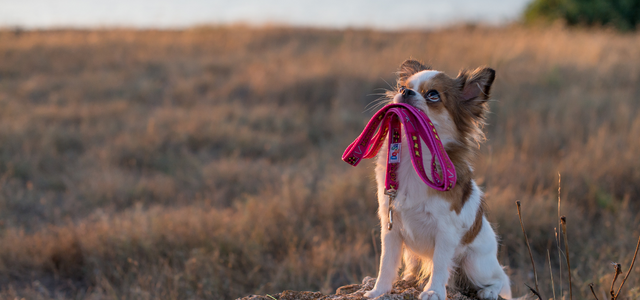
Trying to jump right into leash training without adequate planning is never a good idea.
If you go into this task without a strategy, you are likely to find yourself becoming frustrated and fed up with your puppy. Puppies are full of energy and have short attention spans, making training a monumental challenge for new and experienced owners alike.
Here are three of the most common issues dog owners face when training a puppy to walk on a leash:
- Pulling: Many puppies tend to pull on their leash due to excitement, a lack of training, or a combination of the two. This can make walking a puppy difficult and uncomfortable for the owner, especially when they encounter another person or animal on a walk.
- Lack of Focus: Puppies can be easily distracted by sights and sounds, which can hinder them from staying focused on a walk. For many owners, teaching a dog to focus is an overlooked step in the leash training process — yet, it is arguably the most important step.
- Fear and/or Anxiety: The world is big, bright, and loud. For a puppy (especially a very young one), this can induce fear and anxiety while they adjust to their surroundings. Adding a leash to the mix can unintentionally worsen that fear by making the puppy feel trapped or helpless.
You may have noticed a common denominator in each of these problems: the owner.
Building a sense of confidence and focus in your puppy comes down to your effort as the owner. Just like a human child, a puppy looks to you for guidance and care. As such, it is your responsibility to learn how to control your puppy’s excitement and alleviate their fear and anxiety.
With this in mind, let’s look at five common mistakes owners make when leash-training their puppies:
- Lack of Consistency: Inconsistency in training can lead to confusion and setbacks in leash training. As the owner, it is your job to maintain consistent methods and techniques throughout your training efforts. This applies to all aspects of training, not just leash training.
- Lack of Patience: Training any dog to walk on a leash requires patience but especially so when that dog is a puppy. As much as you need to train your puppy to listen, you must also train yourself to maintain a calm and patient attitude throughout the process — remember that change doesn’t happen overnight for dogs or humans!
- Lack of Positive Reinforcement: Research shows that positive reinforcement is one of the most effective ways to train and gain the respect of a dog (more on that later). Your goal is to reward your puppy when they achieve a new training goal and correct them when they do not. Punishment should be severely limited if it is used at all.
- Not Understanding the Puppy’s Body Language: A dog’s body language is inherently different than a human’s, so you must take the time to learn what their body language means and how to properly respond to it. This is crucial for identifying signs of stress, fear, discomfort, or other feelings that can inhibit successful training.
- Not Adjusting to the Puppy’s Energy Level: Let’s face it — your puppy is going to be hyper. Rather than trying to force them to ignore that excited energy, the key to training is to first expend that energy before you begin your training session. Additionally, you should begin each training session by assessing your pup’s energy level and adjusting the lesson accordingly.
9 Steps for Training Your Puppy to Walk on a Leash
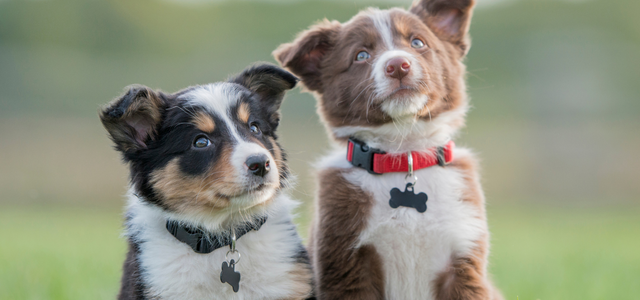
Now that you know what challenges and mistakes to look out for, we can begin the leash-training process.
Every puppy is different, so you will inevitably need to make small adjustments to your training strategy to better match your dog’s personality and energy level. The step-by-step strategy we have outlined below is intended to be used as a framework you can use to build an effective training strategy.
Without further ado, here are the nine key steps for training your puppy to walk on a leash:
1. Choose the Right Collar, Harness, and Leash
Before you can begin training, you need the tools of the trade!
The three most important pieces of puppy gear you need are a collar, a leash, and a harness.
Using both a collar and harness comes with many advantages.
Collars are not the most effective training tools but they are an essential part of puppy apparel, as the collar is generally where you will attach the dog’s name tag, vaccine information, and any other tags.
Ideally, you want your puppy to be able to wear a collar when walking without that collar putting strain on their neck or joints. This is where the harness comes in — a harness gives you better control over your puppy and can help immensely with limiting their ability to pull.
Once you have purchased a collar and harness, adjust the tightness as needed. For a collar, leave enough slack when tightening it for two fingers to fit between the collar and your dog’s neck. The same goes for the harness, except it goes around your dog’s chest and back rather than their neck.
As for the leash, you have five main leash options to choose between:
- Flat Leash: A flat leash is a simple, traditional leash that is made of one piece of material. It is often made of leather or nylon, and typically has a clip on one end that attaches to the collar or harness. Flat leashes are great for puppies because they are lightweight and easy to handle.
- Retractable Leash: Retractable leashes have a cord or tape inside that can lock at different lengths, giving your dog greater freedom. However, these leashes are not recommended for new puppies as they offer less control and can be dangerous if the puppy pulls or runs too quickly.
- Flexi-Leash: Flexi-leashes are similar to retractable leashes, but they have a thicker cord or tape inside. Like retractable leashes, flexi-leashes are not recommended for new puppies, as they are difficult to control and can be dangerous if the puppy pulls or runs too quickly.
- Short Leash: A short leash is about 4 to 6 feet long and is sometimes called a city leash. This type of leash is good for puppies because it gives them enough room to explore while still being close enough to the owner to ensure their safety.
- Training Leash: A training leash is a type of short leash that attaches to the front of the harness, giving the owner more control over the puppy's movements. These leashes are also a great choice when teaching your puppy specific commands or behaviors.
In general, it's best to start with a flat, short, or training leash when training a new puppy. These types of leashes are easy to handle and provide a good level of control. As your puppy becomes more experienced, you can consider a retractable or flexi-leash if you choose to.
2. Let Your Puppy Get Used to Wearing a Collar or Harness First
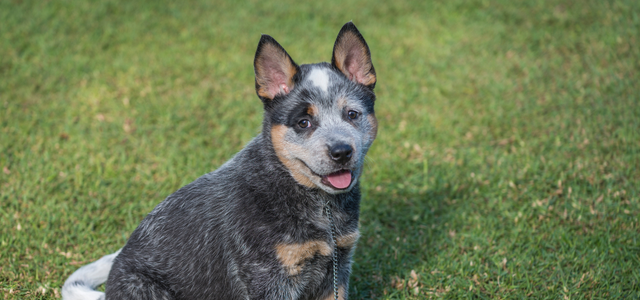
The second key step is to not overwhelm your puppy by introducing all the new gear at once.
Start by putting on their collar and adjusting it as needed. Your puppy will likely try to mess with the collar and attempt to get it off. As such, training your puppy not to mess with their collar is the first lesson you should teach them. The same goes for the harness, which you should introduce after the puppy has adjusted to wearing the collar.
To train your puppy to not mess with their collar or harness, follow these steps:
- Watch your puppy closely so you can correct the behavior when it happens
- When your puppy begins trying to remove the collar or harness, correct them with a firm “No.” If they are chewing at the collar or harness, stop them from doing so at this step as well.
- After correcting your puppy, watch them for a few more seconds. If they successfully stop messing with the collar or harness, reward them with praise and/or a treat to reinforce the lesson.
It is also a good idea to give your puppy time away from the collar and harness as well.
Just as a human would not want to wear jewelry or professional clothing all the time, your puppy is not going to want to wear a collar or harness all day long. When they are inside and training is done for the day, you can remove their collar and harness to let their skin and fur air out.
Removing a collar or harness (especially when sleeping at night) can also ensure your puppy does not develop hot spots from the constant friction of the material against their skin and fur.
3. Introduce Your Puppy to the Leash
Once your puppy is comfortable with wearing their collar or harness, you can introduce the leash.
Like with the collar and harness, your puppy’s first instinct may be to chew at the leash and try to detach it from themselves. To correct this behavior, simply attach the leash to their harness or collar and let them drag it around. Follow the same steps outlined above — correct the behavior when they try to mess with the leash and reward them with treats or praise when they successfully leave it alone.
After letting them walk around freely for a while as they get used to wearing the leash, you can pick it up and begin walking them around your home, yard, or neighborhood.
4. Use Treats & Praise to Train Your Puppy to Focus & Stop Pulling
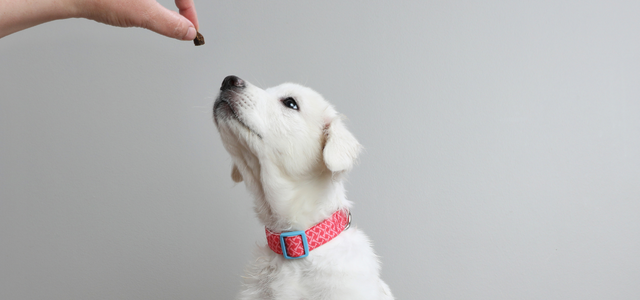
As we touched on earlier, training your puppy to focus is a crucial yet often overlooked step.
Using a command such as “Look” or “Watch Me,” you can begin training your puppy to look at you on command. This can be accomplished through these steps:
- Hold a treat at your eye level and say your chosen command. Have your puppy stare up at the treat for a few seconds before rewarding them.
- When they have formed the association between the verbal command and the behavior of looking up at the treat, stop using the treat and focus instead on having them make eye contact with you. This is the purpose of holding the treat in front of your face to begin with, as this teaches your puppy to look at your face and eyes when they hear the command.
- The first few times, reward your puppy instantly for looking at you. As you progress, make them wait for longer periods while continuing to look at you before rewarding them.
This is the foundational skill needed to ensure you can get your puppy’s attention while on a leash. After they master this skill off-leash, begin practicing it on-leash in your home and away from distractions.
As you begin walking your dog on-leash, continue to practice the focus command. This will also help you to train your puppy not to pull, as you can give the focus command to get their attention.
To correct pulling behavior, follow these steps:
- Hold the leash loosely and let your puppy lead you
- When the leash goes taught from pulling, stop moving until the puppy stops pulling (if they have mastered the focus command, now is a great time to practice it!)
- After your puppy stops pulling, reward them with a treat or praise (if you are using the focus command, reward them for responding correctly to the command as well)
- Rinse and repeat — training your puppy to stop pulling is all about repeating this stop-and-start action over and over until they get it
5. Start in Your Home or Yard Before Venturing into Public
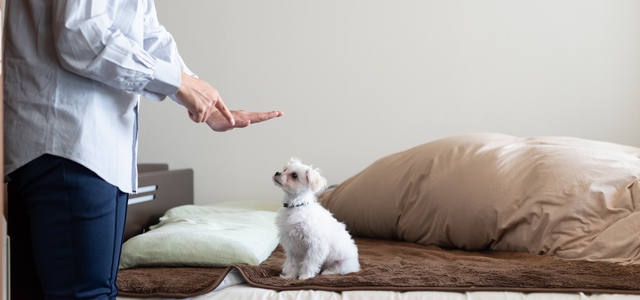
Distractions are often the death of puppy training.
Even if your puppy has begun to master the focus command, taking them into a crowded public place is the best way to squander your hard work up to this point. The better strategy is to begin leash training in your own private home or yard that is free from unwanted distractions.
As your puppy masters walking on a leash in this quiet and controlled environment, then you can begin venturing into public and adding new distractions to the mix — which leads us directly to our next step.
6. Begin Introducing Distractions Slowly
Distraction-based training is the process of introducing new distractions to your puppy after they have begun to master a skill without distractions.
These distractions can include objects, food, dogs, and people.
When training within your home, you can begin introducing distractions like toys and treats to the mix, not allowing your puppy to interact with the distraction until you give them permission to do so.
You can also have friends and family come over to teach your puppy to not become distracted by other people, as well as teach them how to respect a person’s space.
As for introducing your puppy to dogs, this can be a little trickier.
Once again, you can have friends and family with dogs bring their dogs over. Keep in mind that your puppy is likely to be excited by and/or afraid of the new dog, so give them time to adjust to the presence of the other animal before beginning a training session.
As discussed in the step above, your best bet is to begin distraction training at home before venturing out into public where there are infinitely more distractions to deal with.
7. Differentiate Training Walks from Exercise Walks
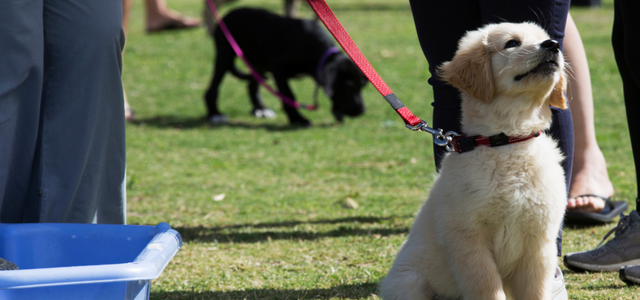
Throughout this guide so far, we have touched on the importance of assessing your puppy’s energy levels and allowing them to get used to their surroundings before beginning a training session.
The same concept applies as you begin taking your puppy for walks outside of your private home or yard. Your puppy should be given the freedom to act like a puppy and get their energy out before starting any sort of intensive training for the day.
However, this does not mean you should not be consistent with your corrections. It simply means you should differentiate training walks from exercise walks.
During an exercise walk, you should still correct your puppy’s behavior if they become distracted or misbehave. The key difference is that an exercise walk is meant to entertain them and get them active, whereas a training walk is all about making them focus for long periods.
Establishing a good balance of both types of walks is vital to building long-lasting habits in your puppy.
8. Gradually Increase the Duration & Frequency of Walks
After your puppy starts to show good progress with the foundational leash-training skills (the focus command, learning not to pull, and ignoring distractions), the next step in your leash-training process is simply to go on longer and more frequent walks.
As you go on these walks, make sure you are remaining consistent in your commands and corrections. Repetition is crucial for solidifying a lesson in your dog’s mind, so stick with it and continue to reinforce the skills your puppy has learned so far.
Throughout your training, remember this key takeaway — you, as the owner, have foundational skills to learn and practice as well. These skills are patience, consistency, and confidence.
We’ve already discussed the importance of patience and consistency. When it comes to confidence, this refers to how you are giving commands and your overall attitude. Your puppy is likely to mirror your behavior in some ways, so if you go into training with noticeable anxiety or stress, your puppy may begin feeling the same attitude toward training.
9. Work with a Professional Trainer
Our final step is an optional yet highly useful one — work with a professional trainer.
Professional dog trainers can help you not only instill great behaviors and habits in your puppy but also excellent training skills within yourself.
If you have never trained a dog before or do not feel particularly confident in your ability to do so, a professional trainer can assist you in learning:
- The right commands to use for specific behaviors
- How and when to correct a bad behavior
- How and when to offer a reward for good behavior
- How to maintain a patient and calm attitude during training
- How to build both your puppy’s and your own confidence
- Socializing your puppy with other people and animals
Though a professional trainer is not a necessity — plenty of dog owners train their puppies to be well-behaved all on their own — working with a trainer can give you the foundational knowledge you need to feel confident in your training efforts.
The Power of Paws-itive Reinforcement
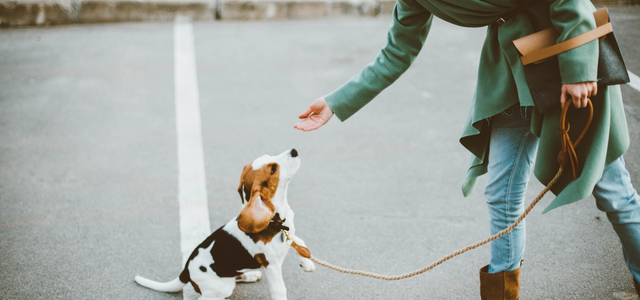
A big part of knowing how to train a puppy to walk on a leash is simply understanding canine behavior.
Dogs respond to positive reinforcement and learn to take cues from your encouragement and rewards.
There is plenty of research out there that shows that positive reinforcement is the best way to establish long-lasting and healthy habits through training.
According to a comprehensive research overview published by Companion Animal Psychology, dogs trained with positive reinforcement proved to be more obedient than dogs trained with punishment. Moreover, punishment can cause your dog stress, which can lead to fearful or aggressive behavior. By comparison, positive reinforcement builds a more trusting relationship between an owner and their dog.
Force-free and fear-free training methods are ideal when it comes to positive reinforcement.
Not only are these more humane, but they’re also simply more effective — most dogs readily understand that the absence of positive reinforcement is indicative that they have behaved badly, prompting them to stop the bad behavior in anticipation of a reward.
Training Recap: 6 Key Takeaways for Leash-Training a Puppy
As we close out this guide, we want to leave you with six of the most important takeaways for training a puppy to behave on a leash:
- Establish Clear Boundaries: Whether you are training your puppy new skills or simply teaching them the rules of your home, starting early is key. By establishing clear boundaries, you give your puppy the structure and consistency they need to thrive.
- Socialize Your Puppy: Even if you live alone, your puppy will inevitably encounter other humans and animals. As part of your leash-training (and overall puppy-training strategy), it is crucial to slowly introduce your puppy to other dogs, animals, and people.
- Use Positive Reinforcement: Positive reinforcement is the best way to not only successfully train your dog but also build a healthy and happy relationship with them. Provide treats or praise when they behave correctly and use a calm but firm voice when giving corrections.
- Assess Your Puppy’s Energy: A hyper puppy is not likely to be a good student. Always maintain awareness of your puppy’s energy levels and give them the exercise and entertainment they need before trying to teach them new skills. In addition to being aware of your puppy’s energy, make sure you are giving them enough attention and affection throughout the day as well. This is the key to strengthening your bond and building a strong relationship with your dog.
- Be Consistent at All Times: No matter where you are with your puppy, maintain consistency with your positive reinforcement and corrections. It can be tempting to loosen boundaries when in the comfort of your home but it is crucial to keep those boundaries firmly in place at all times — especially when a puppy is just beginning their training journey.
- Seek Professional Help: Training a puppy is a lot of work! Don’t feel bad if you become overwhelmed and need help, that’s what professional dog trainers are here for.
Get Professional Puppy Training in Edmonton from The Leash Team
If you live in or near Edmonton, work with The Leash Team for all your puppy training needs!
Our experts at The Leash Team can help you train your puppy to walk on a leash with confidence and ease. No matter the breed or temperament of your puppy, The Leash Team is here to support you. We’ve worked with all types of dogs and owners who have walked away happy with their results.
The Leash Team’s private dog training classes offer both basic dog training and advanced dog training.
Our range of services includes puppy training, as well as a wide variety of other obedience training classes that will help you turn your dog into a well-behaved and fun-loving pooch.
At The Leash Team, we help you and your dog understand each other better.
Get in touch with The Leash Team to sign-up for a class today!